
March 1957 to January 1973
British European Airways Corporation (BEA)
G-AOHI - c/n 158 - a V.802 series Viscount
United Kingdom registered
11 February 1953
An order was placed for the first 800 series Viscount which was specifically designed for British European Airways Corporation (BEA).
Initially the order was for twelve Type 801 aircraft, which was actually longer than the Type 802 which BEA finally decided to receive.
This was the 9th Type 802 ordered by British European Airways Corporation (BEA).
Production Order No. F09/802. Sales Order No. F09/63B. Stock Order No. F09/26B.
26 February 1957
First flight from Brooklands Airfield, Weybridge, Surrey, England.
It landed at Wisley Airfield, Surrey, England for fitting out and test flying.
8 March 1957
Certificate of Airworthiness (CofA) issued.
11 March 1957
Delivered to British European Airways (BEA) named as 'R M A Charles Montagu Doughty'.
16 March 1957
Noted at Blackbushe Airport, Hampshire, England due to a London Airport weather diversion.
14 April 1957
Operated the first V.802 Viscount service from London Airport (Heathrow), Middlesex, England to Collinstown Airport, Dublin, Ireland service flown by Captain G T Greenhalgh.
29 October 1958
Noted at Blackbushe Airport, Hampshire, England due to a London Airport weather diversion.
8 December 1958
Noted at Gatwick Airport, Surrey, England carrying out ILS approaches and overshoots. It then returned to London Airport (Heathrow).
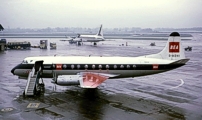
BEA
'Red Square' livery
March 1959
A new BEA 'Red Square' livery was adopted and aircraft were repainted during the early 1960s when they next went in for overhaul.
This aircraft was not repainted in the 'Red Square' livery due to its premature demise.
31 March 1959
BEA annual report quotes a total time of 3,997 hours.
29 December 1959
Overshot the runway during a landing at Turnhouse Airport, Edinburgh, Scotland due to aquaplaning that caused the nose undercarriage leg to collapse.
It finally stopped by the edge of a stream.
This accident resulted in curled propellers and shockload damage to the Rolls-Royce Dart engines.
There were no reported injuries to the 57 or 59 passengers and 5 crew on board.
25 February 1960
Test flight after repairs and replacement Rotol propellers and Rolls-Royce Dart engines carried out at Turnhouse Airport, Edinburgh, Scotland.
8 December 1960
Noted at Gatwick Airport, Surrey, England due to a London Airport (Heathrow) weather diversion.
12 December 1962
Noted at Gatwick Airport, Surrey, England due to a London Airport (Heathrow) weather diversion.
11 November 1964
Noted at Gatwick Airport, Surrey, England due to a London Airport (Heathrow) weather diversion.
June 1965
Noted at Fiumicino Airport, Rome, Italy with the Maltese Cross and 'The Malta Airlines' logo placed over the 'BEA Red Square' logos on the cheat line. It was operating a service from London to Malta using Maltese cabin crews.
26 October 1965
Noted at Gatwick Airport, Surrey, England due to a London Airport (Heathrow) weather diversion.
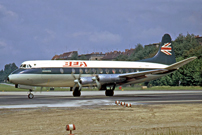
BEA
'Flying Union Jack' livery
circa 1968
A new BEA ‘Flying Union Jack‘ livery was adopted and most aircraft were repainted when they went in for major overhaul, which took some of them into the early 1970s before this was accomplished.
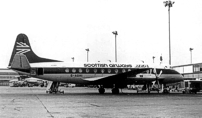
'Scottish Airways' titles added
18 November 1971
Noted with BEA 'Scottish Airways' titles.
19 January 1973
Crashed into Ben More mountain, near Crianlarich, Perthshire, Scotland in a snowstorm during a test flight from Abbotsinch Airport, Glasgow, Scotland after maintenance.
All 4 crew members, Captain Walter Durward, First Officer Stanley Kemp, Engineer Paddy Quinn and Engineer Jimmy Moore sadly died in the crash.
Total time 32,677 hours.
Summary
The aircraft took off from Abbotsinch Airport, Glasgow, Scotland on a visual flight rules (VFR) flight plan for an air test and flew north at flight level (FL) 40 for approximately seven and a half minutes before the captain asked for clearance back into the Glasgow Control Zone. This was the last message received. About two minutes later the aircraft struck near the summit of Ben More which is at 3,852 feet / 1,174 metres and disintegrated. There were no survivors.
The report concludes that the pilot did not maintain a safe altitude and gave insufficient attention to navigation when flying VFR into an area of snow covered high ground in marginal weather conditions.
Investigation
History of the flight
The day prior to the accident the aircraft had been scheduled to fly a normal passenger service from Birmingham International Airport, West Midlands, England to Turnhouse Airport, Edinburgh, Scotland but because of bad weather at Edinburgh and also at Glasgow, the nominated diversion, it had landed at Prestwick Airport, Ayrshire, Scotland. During this flight the autopilot had malfunctioned and the aileron control appeared unusually heavy. After landing at Prestwick these defects were entered into the technical log.
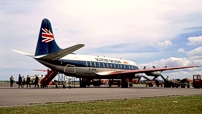
A BEA ground engineer checked
the aileron controls
A BEA ground engineer checked the aileron controls and trim and found nothing amiss. Consequent of this check the captain agreed to take the aircraft to Glasgow on an engineering flight with the autopilot still unserviceable (an allowable deficiency), in order that a full investigation of the defects could be made. During this positioning flight, which was flown manually, the first officer found the aircraft still flew a little left wing heavy. The ground engineer, who had previously checked the aircraft, flew on this flight as an observer.
The following morning, that is the day of the accident, the aircraft was given a full ground check using test equipment and no defects were found in the aileron trim mechanism or the autopilot. However, the two engineers concerned with the tests wished to satisfy themselves that there was no intermittent fault which might only show up in the air, and asked for the aircraft to be given an air test; this was arranged for the early afternoon.
Captain Durward and Second Officer Kemp (the standby crew) were detailed for the test flight and an Air Traffic Control (ATC) flight plan was filed for a 15 minute VFR local flight. It was established that after reporting at BEA Operations, the captain visited the meteorological office but did not speak to the Duty Forecaster apart from saying he was going on a local test flight. He later proceeded to the aircraft and was heard discussing the reported defects with the two engineers who were to accompany him on the flight.
At 1416 hrs the aircraft was cleared to taxi to Runway 06. The captain informed ATC that he would fly in a northerly direction for about ten minutes climbing to FL 40 and then return for an instrument landing system (ILS) approach. This message was acknowledged by ATC who later cleared the aircraft to leave the Glasgow Zone to the northwest climbing to FL40.
The aircraft was airborne at 14:22 hrs and at 14:23.30 hrs the pilot reported crossing the GLG non-directional radio beacon (NDB), sited at the ILS outer marker for runway 24, turning on to a northerly heading and climbing to FL 40. The aircraft was monitored by Glasgow Radar until contact was lost on a bearing of 020 degrees magnetic at 19 nm. Loss of radar contact in this area at this height and range from Glasgow is normal. A few minutes later, at 14:29.37 hrs, the pilot called Glasgow Radar and said 'Hotel India would accept a positioning back to the ILS for 06 now'. The aircraft was cleared at FL 40 to the AC NDB, sited at the ILS outer marker for Runway 06; this clearance was acknowledged.
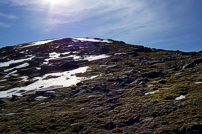
Ben More mountain
At 1432 hrs Glasgow Approach passed the 1420 hrs Glasgow weather report to the aircraft but there was no reply to this transmission, nor to all subsequent attempts to contact the aircraft an all possible frequencies. At 14:39 hrs ATC initiated the Distress Phase of Alerting Action of the Search and Rescue Organisation, and the Rescue Co-ordination Centre at Pitreavie was advised. At 16:55 hrs the aircraft's endurance was considered exhausted and since all further attempts to locate or contact the aircraft had proved negative, it was assumed that an aircraft accident had occurred at an unknown location.
The aircraft, whilst flying on a westerly heading, had struck the mountain near the summit which is at 3,852 feet / 1,174 metres above mean sea level (amsl).
20 January 1973
A search for the missing aircraft was mounted and members of the RAF Leuchars Mountain Rescue Service were the first to find some of the wreckage at various locations on Ben More mountain near Crianlarich, about 31 nm northwest of Glasgow Airport.
Major sections of the wreckage were later found lying further down the mountain near Ben More Burn.
There were 60 servicemen from RAF Kinloss and RAF Leuchars together with many more local volunteers searching the various high locations in the area.
The servicemen were accomodated at Lochearnhead Village Hall, to the east of the search area.
21 January 1973
The bodies of the occupants on board the aircraft were finally recovered from deep snow in a corrie on Meall Daimph, at a height of approximately 2,800 feet / 854 metres (amsl).
After the recovery back to Ben More farm on sleds they were taken away in a BEA helicopter.
22 January 1973
With the weather conditions improving the BEA helicopter was then utilised to transfer teams of 3 from the RAF Mountain Rescue units to newly discovered wreckage sites.
Aircraft information
The records show that the aircraft had been properly maintained and that all mandatory modifications had been embodied. Its certificates of maintenance and airworthiness were valid and it had flown 129 hours since its last Check 1 inspection. The total flying time was 32,677 hours.
Since the last Check 1 inspection the autopilot had operated satisfactorily for 61 hours before a series of unserviceabilities, commencing on 31 December 1972, were reported by flight crews. These reports indicated that during turn demands on the autopilot the aircraft was not responding or was sluggish to respond or was over banking. Various checks and replacement of autopilot components were made but the troubles continued intermittently culminating in the report of autopilot malfunction made by the Captain of the flight on the day prior to the accident. In this incident, during a turn to port, the aircraft continued to turn through the selected heading and lost 400 feet in height. Later during a further turn with the autopilot engaged the aileron trim was seen to run away. After disengagement of the autopilot and with the aileron trim back at the neutral position the aileron controls were reported to have been unusually heavy during manual flying. Following the report a full ground check was carried out and the autopilot and aileron trim were found satisfactory. However, because of this incident and the previous history of autopilot defects, it was decided to carry out an air-test to check on the autopilot and aileron trim systems. It was during this test flight that the accident occurred.
The weight and centre of gravity of the aircraft were within the prescribed limits and at departure from Glasgow the aircraft's fuel tanks contained 800 gallons of aviation kerosene, sufficient for an endurance of approximately 2 hours 40 minutes.
Meteorological information
The following weather observation was recorded at Glasgow Airport at 14:20Hrs: -
Surface wind: 090 degrees / 12 knots
Cloud: 1/8th at 4,000 feet, 8/8ths at 5,000 feet
Visibility: 6 kilometres
Weather: rain and snow
Temperature: +3 degrees centigrade
QNH: 1006.5 milibars
At Glasgow Meteorological Office the Standard practice was for pre-flight meteorological briefing to be given to pilots by the Duty Forecaster; no official provision is made for self-service briefing. However, on this occasion when the captain visited the meteorological office the Duty Forecaster was busy briefing another pilot and apart from saying 'Just local - an air test' as he left the office, the captain did not speak to the forecaster.
At the time the Captain visited the meteorological office, about 13:45 hrs, the following information was on display: -
(1) The current hourly synoptic UK charts
(2) The 0600 hrs Central Forecast Office analysis
(3) The forecast chart for 06:00 hrs the following day, 20 January 1973
(4) The Sigmet board, containing among other sigmets one for the Scottish FIR valid from 12:15 hrs to 16:15 hrs warning of severe turbulence below flight level 100
(5) A television display which gave the Glasgow current observation. This would have been the 13:20 hrs observation which was: -
Surface wind: 100 degrees / 12 knots
Cloud: 3/8ths at 4,500 feet, 8/8ths at 6,000 feet
Visibility: 8 kilometres
Weather: rain and snow
Temperature: +4 degrees centigrade
QNH: 1007.5 milibars
In various trays on the counter within easy reach of visiting pilots, the following documentation was available for inspection and hand-out as necessary: -
The forecast spot upper wind chart.
The significant weather chart.
Aerodrome forecasts (TAFS) for various areas.
It has been established that when the captain visited the meteorological office, he looked at the display information and collected a sheet of TAFS - UK 1 Collective. This sheet contained the forecasts for the Scottish aerodromes, including Glasgow, which was as follows: -
Period of validity: 13:00 hrs to 22:00 hrs.
Surface wind: 120 degrees /15 to 25 knots.
Visibility: 10 kilometres.
Cloud: 5/8ths stratocumulus at 2,000 feet.
Temporarily 13:00 hrs to 22:00 hrs: -
Visibility: 5 kilometres.
Weather: rain.
Cloud: 3/8ths stratus at 1,000 feet. 6/8ths stratus at 1,500 feet.
Although he did not take copies of the significant weather chart and forecast spot upper wind chart, the Captain may well have looked at them.
A post-accident appreciation of the weather conditions in the area within 60 miles north of Glasgow gave the main cloud base as 4,000 feet or above with almost continuous snow. Pilots had reported that they could not detect a cloud base because the snow was heavy enough to merge with the cloud. Witnesses close to the scene of the accident said that at the time there were strong winds with snow and poor visibility.
This weather appreciation gave the wind at 4,000 feet as southerly at 50 knots and indicated that serve turbulence could have been expected in the vicinity of high ground. A plot of the aircraft's air and ground tracks, made from information obtained from the flight recorder, suggests that the actual 4,000 feet wind was 150 degrees/40 knots.
Aerodrome and ground facilities
Glasgow's Abbotsinch Airport is situated 6 nm west of the city of Glasgow and is within the Scottish Control Zone, the northern boundary of which lies approximately 9 nm from the airport.
According to the official ICAO instrument approach and landing charts for Glasgow published by the Department of Trade and Industry and now by the Civil Aviation Authority, the minimum sector altitude in the area 25 nm north of the airport was 4,400 feet. BEA also gave the identical information on their own published instrument approach charts.
The definition of minimum sector altitude which is applied, via the Aeronautical Chart (Map) section of the Air Pilot, to United Kingdom legislation is given in ICAO PANS document 8168-OPS/611, Aircraft Operation, which is as follows: -
The minimum sector altitude is the lowest altitude which may be used under emergency conditions which will provide a minimum clearance of 1,000 feet above all obstacles located in an area contained within a sector of a circle of 25 nm radius centred on a radio aid to navigation.
In this case the radio aid was the ILS localiser transmitter for Runway 06.
BEA's minimum safe altitude for that sector of the route from Glasgow to Inverness, which passes 9 nm east of Ben More, is given as 5,000 feet for an area 10 nm either side of track and 6,000 feet for an area 30 nm either side of track; the latter is the one customarily applied by BEA pilots.
circa February 1973
Substantial remains of the aircraft were removed from Ben More Burn by Hardgate Metals Ltd and taken to their yard at Clydebank on the A82 near Dumbarton, Scotland for processing.
A lot of the smaller sections of wreckage remained on the mountain including a starboard rear fuselage skin, two skin panels with window openings and a pair of main undercarriage wheels still attached to the severed leg. Even smaller parts were scattered over a larger area including the high corrie of the Sloc Curraidh.
Most of these parts were still there decades later which is how it should be, as the removal of such items is considered to be not acceptable.
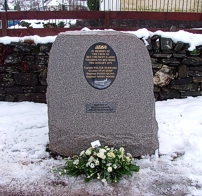
Crash memorial
19 January 2005
Mike Durward, son of Captain Walter Durward, and two BEA colleagues David Whittick and Bob Elrick attended a church memorial service at Crianlarich near Ben More, Perthshire, Scotland where a granite memorial had recently been installed next to the pathway leading to the church.
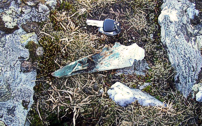
Wreckage in 2007
2007
James Towill climbed to the crash site and took this photo of a small wreckage fragment and the one above of Ben More. The car keys indicate the scale of the fragment.
15 August 2019
Eddie Boyle found a large section of the starboard rear fuselage skin lying near a barbed wire fencing on the edge of a lower level wooded area near Ben More Farm.
October 2020
Bryan Denny found a pair of main undercarriage wheels lying in a gulley on the South Eastern side of Ben More.
They must have become detached from the aircraft as it impacted the mountain and disintegrated.
 FURTHER READING: Books about BEA - British European Airways FURTHER READING: Books about BEA - British European Airways
|



